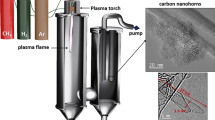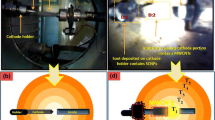Abstract
Carbon material was produced using an inductively coupled thermal plasma torch system of 35 kW and a conical shape reactor. The carbon nanopowders were obtained by plasma decomposition of methane at various flow rates and show a uniform microstructure throughout the reactor. The product has a crystalline graphitic structure, with a stacking of between 6 and 16 planes and a nano-flake morphology with particles dimensions of approximately 100 nm long, 50 nm wide and 5 nm thick. Nitrogen was also introduced in some synthesis experiments along with the methane precursor using flow rates of 0.1 and 0.2 slpm. The resulting product has the same structural properties and the nitrogen is incorporated into the graphitic structure through pyridinic type bonds.









Similar content being viewed by others
Notes
Carbon Black User’s Guide. Safety, Health, and Environmental Information. International carbon black association (ICBA) www.carbon-black.org.
Induction Plasma Torch PL-35 and PL-50, Operation and Service Manual. Sherbrook: Tekna Plasma Systems, Inc., 2004.
National Institute of Standards and Technology (NIST), X-Ray Photoelectron Spectroscopy Database Version 3.5, www.nist.gov.
References
Donnet J-P, Voet A (1976) Carbon black. Physics, chemistry, and elastomer reinforcement. Marcel Dekker Inc, USA
Fabry F, Flamant G, Fulcheri L (2001) Carbon black processing by thermal plasma. Analysis of the particle formation mechanism. Chem Eng Sci 56:2123–2132
Girshick SL, Chiu CP, McMurry PH (1988) Modelling particles formation and growth in a plasma synthesis reactor. Plasma Chem Plasma Process 8:145–157
Girshick SL, Chiu CP (1989) Homogeneous nucleation of particles from the vapor phase in thermal plasma synthesis. Plasma Chem Plasma Process 9:355–369
Fulcheri L, Schwob Y, Flamant G (1997) Comparison between new carbon nanostructured produced by plasma with industrial carbon black grades. J Phys III France 7:491–503
Juan L, Fangfang H, Yiwen L, Yongxiang Y, Xiaoyan D, Liao X (2003) A new grade carbon black produced by thermal plasma process. Plasma Sci Technol 5:1815–1819
Kim KS, Seo JH, Nam JS, Ju WT, Hong SH (2005) Production of hydrogen and carbon black by methane decomposition using DC-RF hybrid thermal plasmas. IEEE Trans Plasma Sci 33:813–823
Antolini E, Salgado JRC, Giz MJ, Gonzales ER (2005) Effects of geometric and electronic factors on ORR activity of carbon supported Pt-Co electrocatalysts in PEM fuel cells. Int J hydrogen Energy 30:1213–1220
Litster S, McLean G (2004) PEM fuel cell electrodes. J Power Sour 130:61–76
Barbir F (2005) PEM fuel cells. Theory and practice. Elsevier Inc, USA
Médard C, Lefevre M, Dodelet J-P, Jaouen F, Lindbergh G (2006) Oxygen reduction by Fe-based catalysts in PEM fuel cells conditions: activity and selectivity of the catalysts obtained with two Fe precursors and various carbon supports. Electrochim Acta 51:3202–3213
Lefevre M, Dodelet JP (2000) O2 reduction in PEM fuel cells: activity and active site structural information for catalysts obtained by the pyrolisis at high temperature of Fe precursosrs. J Phys Chem B 104:11238–11247
Jaouen F, Lefevre M, Dodelet JP, Cai M (2006) Heat–treated Fe/N/C catalysts for O2 electroreduction: are active sites hosted in micropores? J Phys Chem 110:5553–5558
Lee K, Zhan L, Zhan J (2008) PEM fuel cell electrocatalysts and catalyst layers: fundamentals and applications. Springer-Verlag London Limited, London
Castillo IA, Munz RJ (2007) New in situ sampling and new in situ sampling and analysis of the production of CeO2 powders from liquid precursors using a novel wet collection system in a rf inductively coupled thermal plasma reactor. Part 1: reactor system and sampling probe. Plasma Chem Plasma Process 27:737–759
Pristavita R, Mendoza-Gonzales NY, Meunier JL, Berk D (2010) Carbon blacks produced by thermal plasma: the influence of the reactor geometry on the product morphology. Plasma Chem Plasma Process 30:267–279
Li N, Wang Z, Zhao K, Shi Z, Gu Z, Xu S (2009) Large scale synthesis of N-doped multi-layered graphere sheets by arc-discharge method. Carbon 48:255–259
Moreno-Couranjou M, Monthioux M, Gonzalez-Aguilar J, Fulcheri L (2009) A non-thermal plasma process for the gas phase synthesis of carbon nanoparticles. Carbon 47:2310–2321
Ferrari AC, Meyer JC, Scardaci V, Casiraghi C, Lazzeri M, Mauri F, Jiand D, Novoselov KS, Roth S, Geim AK (2006) Raman spectrum of graphene and graphene layers. Phys Rev Lett 97:187401
Larouche N, Stansfield BL (2010) Classifying nanostructured carbons using graphitic indices derived from Raman spectra. Carbon 48:620
DiLeo R, Landi BL, Raffaelle RP (2007) Purity assessment of multiwalled carbon nanotubes by Raman spectroscopy. J Appl Phys 101:064307
Inagaki M (2000) New carbons. Control of structure and functions. Elsevier Science Ltd, UK
Acknowledgments
The financial contributions of the Natural Sciences and Engineering Council of Canada, FQNRT and General Motors Canada are gratefully acknowledged.
Author information
Authors and Affiliations
Corresponding author
Rights and permissions
About this article
Cite this article
Pristavita, R., Meunier, JL. & Berk, D. Carbon Nano-Flakes Produced by an Inductively Coupled Thermal Plasma System for Catalyst Applications. Plasma Chem Plasma Process 31, 393–403 (2011). https://doi.org/10.1007/s11090-011-9289-0
Received:
Accepted:
Published:
Issue Date:
DOI: https://doi.org/10.1007/s11090-011-9289-0




